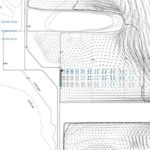| Location | Philadelphia, PA |
| Date | Fall 2014- |
| Principals | Karen M’Closkey + Keith VanDerSys |
| Collaborators | Jieping Wang |
This research explores wetland suitability strategies that are directly guided by energy and elevation parameters, collected and modeled by us. The computational capacities of geospatial analysis (GIS), computational flow dynamics (Aquaveo SRH-2D), and parametric software (Grasshopper) are utilized to develop a new design methodology: generative analysis. With these new computational tools, analytic data can now directly inform design formation and organization.
These tools have also greatly expanded our ability to engage and guide complex physical processes which typically lay outside of our immediate apprehension. In response to these uncovered complexities, a set of biotechnical prototypes are being developed to create a series of new living shorelines along the Delaware. These interventions are meant to dynamically register and reconfigure the endemic landscape; making visible the subaqueous performance that typically remains invisible. They function both as utility-scale wetlands and didactic instruments. As new types of “environmental art forms,” they re-activate the public spaces along the Delaware, both ecologically and experientially.

















